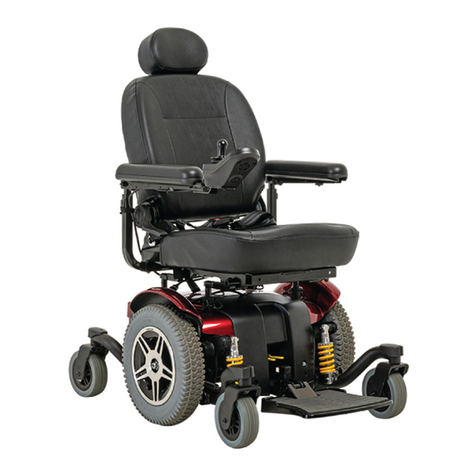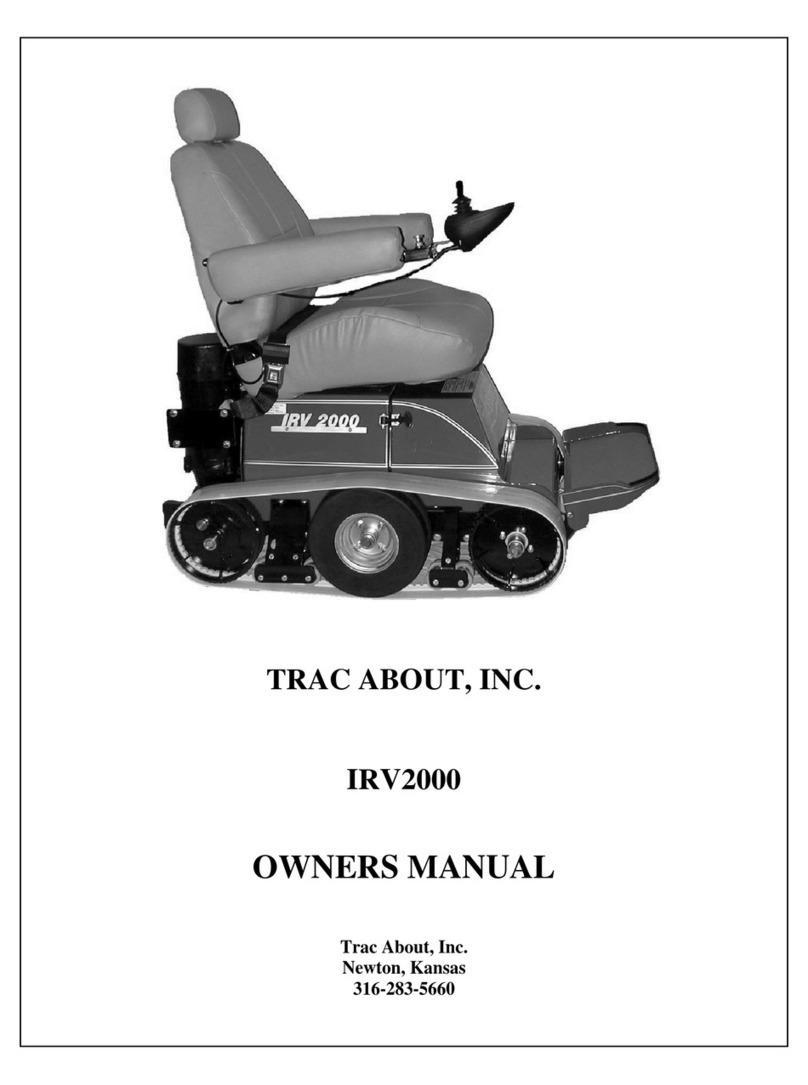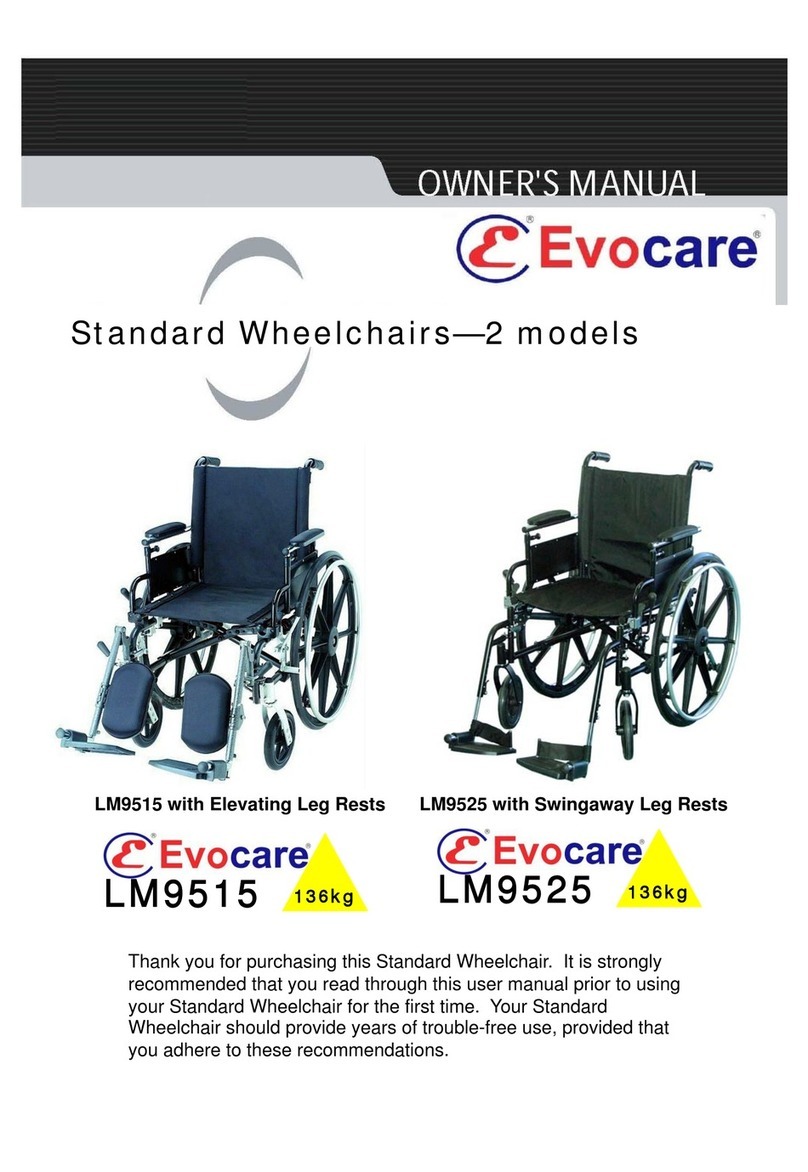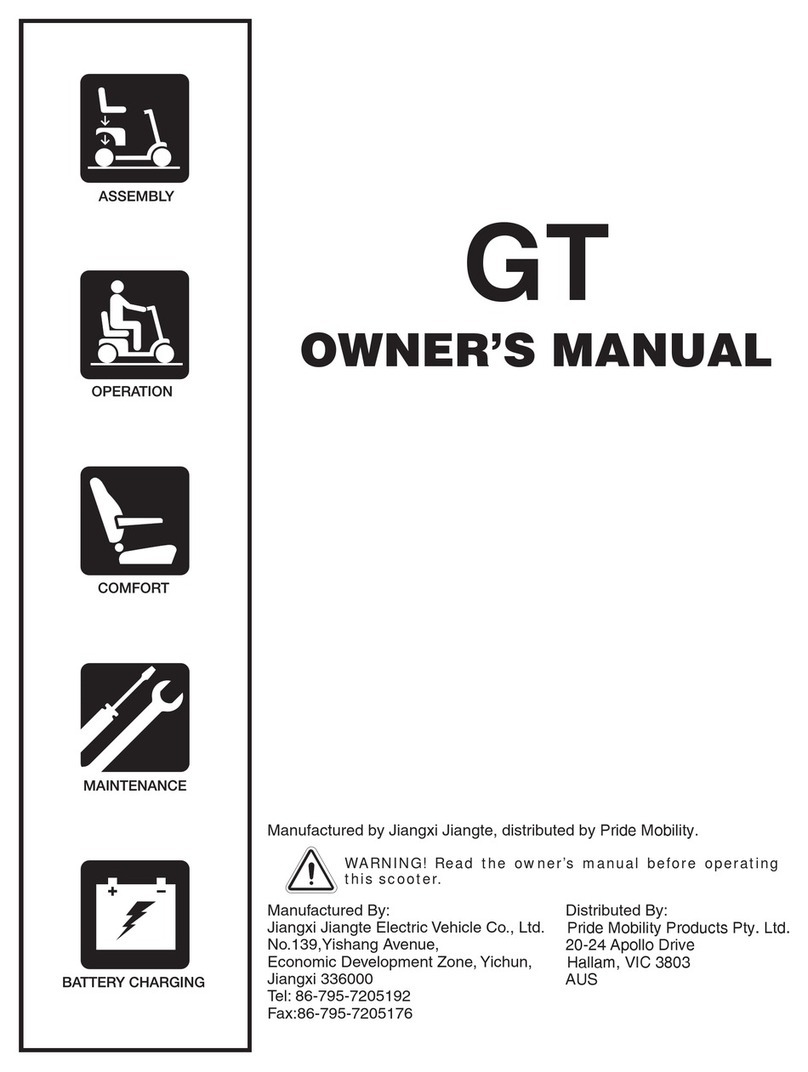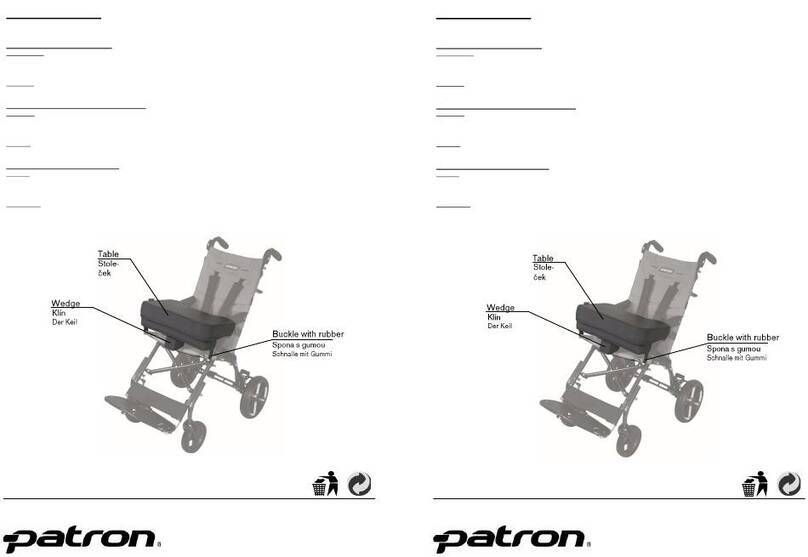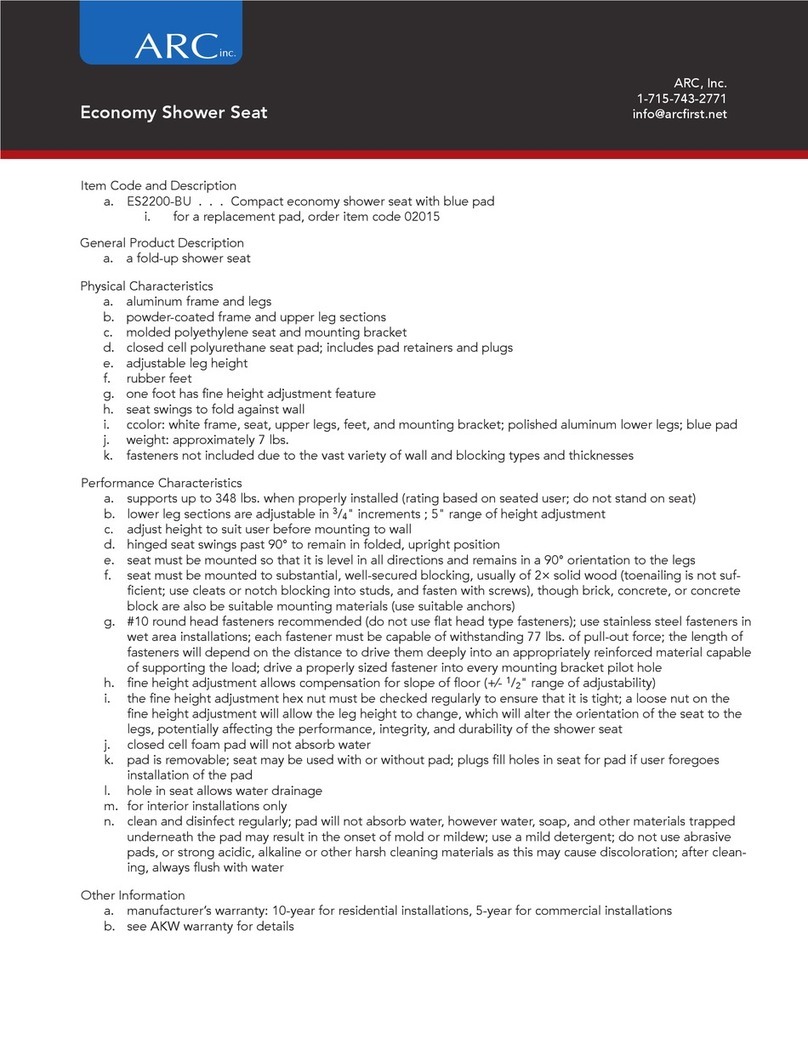ONE COYOTE T User manual

ver 2022.11.01E
OWNER’S MANUAL
Tilt Wheelchair

Foot
Plate
Padded
Armrest
Hand Grip
Wheel
Locks
16” Solid
Rear Wheel
Back
Upholstery
Seat Rail
8” Caster
2
OWNER’S MANUAL
Tilt Wheelchair
Headrest
Tilt
Elevating
Footrest
Abductor
Back gas spring
Anti-tipper
Seat
gas spring

3
1. Maintenance
and Repair
1.1 Guidelines
1. Store the wheelchair in a dry
place and avoid caustic
chemical substances such as oil,
acid, alkali, etc.
2. Keep the wheelchair clean. Use
soap and water to clean the
wheelchair. Dry it quickly and put
some lubricating oil on the
moving parts after cleaning.
3. Avoid using in rain and do not
submerge in water. Do not shower
with this wheelchair. If the
wheelchair gets wet, dry quickly
and put some lubricating oil on
the moving parts.
4. This is a portable daily wheelchair.
Do not play sports in this
wheelchair.
5. You should often check the air
pressure and wear of the rear
tires. Change if necessary.
6. The spokes of the driving wheels
should be adjusted once a year.
7. You should add two or three
drops of high grade motor oil to
the driving wheels and the front
wheels every month.
8. You should clean the wheel
bearing of hair and other debris
often.
OWNER’S MANUAL
Tilt Wheelchair
9. To ensure safety, you should often
check the operation of the brake
and backrest.
1.2 Disinfecting
Please do any disinfection under
guidance by a technician only.
1.3 Maintaining the tires
1. The rear wheels of wheelchair are
pneumatic. The suitable tire
pressure is labeled on the tire.
Please check before use.
2. Check the wear of tires regularly.
Change if necessary.
3. Adjust the wheel lock regularly to
match the wear of the tire.
WARNING
DO NOT operate the equipment
without first reading and
understanding this manual.
If you are unable to understand the
warning, caution, and instruction,
contact a healthcare professional,
otherwise injury or damage may
result.
Intended Use
The Tilt wheelchair is designed for
children with disabilities. It is a
manual wheelchair.

4
NOTE: For this procedure, refer to
Figure 1.
2.1 Reaching, Leaning and
Bending-Forward
Position the front casters so that they
are extended as far forward as
possible and engage wheel locks.
DO NOT ATTEMPT TO REACH OBJECTS
IF YOU HAVE TO MOVE FORWARD IN
THE SEAT OR PICK THEM UP FROM THE
FLOOR BY REACHING DOWN
BETWEEN YOUR KNEES
OWNER’S MANUAL
Tilt Wheelchair
2. Reaching, leaning
and bending
2.2 Reaching, Leaning and
Bending-Backward
Position wheelchair as close as
possible to the desired object. Point
front casters forward to create the
longest possible wheelbase. Reach
back only as far as your arm will
extend without changing your sitting
position.
Figure 1
Figure 2
2. 3 Tippings/Stairways
NOTE: For this procedure, refer to
Figure 2.
When tipping the wheelchair, it
requires two (2) ass stant The second
assistant should be positioned at the
front of the wheelchair lifting
upward on a non-removable
(non-detachable) part of the
wheelchair frame when lifting the
wheelchair and stabilizing the
wheelchair when the wheelchair is
being lowered to the ground.The
first assistant should stand on the
sidewalk and turn the wheelchair so
that the rear wheels are against The
curb. Turn the anti-tippers so the
anti-tip wheels are pointing up, The
wheelchair should be tilted back to
the balance point and, in one
continuous upward movement, the
rear wheels should be pulled up and
over the curb.
Second
assistant
First
assistant

Figure 4
5
3. Function
OWNER’S MANUAL
Tilt Wheelchair
3.1 Arm guard
The arm guard is used to prevent
the users from swaying.
NOTE: For this procedure, refer to
Figure 4.
Removing: Press the pin upwards to
remove the bolt, then pull the arm
guard outward.
Installing: Put the arm guard into
chair frame, then install the bolt to
fix the arm guard.
Figure 3
2.4 Stairways
NOTE: For this procedure, refer to
Figure 3.
1. Remove the anti-tippers from the
wheelchair.
2. Similar steps with tippings above.
3. The wheelchair should not be
lowered until the last stair has
been negotiated and the
wheelchair has been rolled away
from the stairway.
3.2 Side guard
The side guard is used to fix the
sitting position of users.
NOTE: For this procedure, refer to
Figure 5.
Operate the adjustment knob to
install or remove the armrest or

6
OWNER’S MANUAL
Tilt Wheelchair
3.3 Abductor
NOTE: For this procedure, refer to
Figure 6.
The abductor is used to prevent the
user pitching because of inertia.
To install or remove the abductor
please use the adjust knob.
3.3 Detachable footrest
NOTE: For this procedure, refer to
Figure 7.
Removing: Unscrew the control
handle, then swing the footrest
outward. Pull up the footrest until it
clears the pin.
Installing: Put the pin into the hole
from side, then swing the footrest
until it is locked into place on the
chair frame.
3.4. Raise/Lower the footrest
NOTE: For this procedure, refer to
Figure 8.
Raising: Pull up the footrest vertically
to the position you want.
Dropping: Hold the footrest and
push the control handle toward the
rear wheel of the wheelchair at the
same time. The footrest will drop
down automatically. Release the
handle after you finish the
adjustment.
Figure 5
Figure 6
Figure 7
adjust its height. After any
adjustment, make sure the knobs
are fixed.
Adjust knob
Pin
Control
handle
Pin hole
Footrest
Figure 8
Control
handle

4. Basic Operation
4.1 Unfold and Fold the wheelchair
NOTE: Please remove the seat,
back and the pillow before you fold
or unfold thewheelchair!
NOTE: For thi s procedure, refer to
Figure 10.
To detach, press the button. The pin
will exit from the chair frame, then
you can strip the seat and back.
When installing, make sure the pins
are locked in the chair frame tightly.
NOTE: For this procedure, refer to
Figure 11.
When remove the pillow, press the
lock button. The pillow support can
be pulled vertically from the chair
frame.
When installing, put the pillow
support into the chair frame and
make sure the lock button is locked
in the receiver hole. To adjust the
height of the pillow, please operate
the height adjust knob.
4.2 Unfolding
Press down the support bar
vertically until the wheelchair is
unfolded completely. Install the
seat, back and the pillow, then fold
down the footplates.
4.3 Folding
Pivot footplates upwards to vertical
position, remove the seat, back
and the pillow, then pull up the
support bar vertically to fold the
wheelchair.
5.1 Stability
Before using ANY recline position of
this wheelchair, make sure the rear
wheels are in the best position to
maintain the stability of the
wheelchair.
The seat height, seat angle, pivot
point of seat frame, seating system,
caster position, size and position of
the rear wheels, as well as the user
condition directly relate to the
stability of the wheelchair.
Any change to one or any
combination above may cause the
wheelchair to lose stability. These
adjustments MUST be performed by
an authorized dealer or qualified
technician.
Before using the recliner option,
make sure the anti-tipper wheel
assemblies are in the lowest
adjustment hole. (Adjustment hole
closest to the ground/floor).
Figure 10
5.2 Safety information
1. Unless otherwise noted, all
service and adjustment should
be performed while the
wheelchair is noccupied.
2. ALWAYS keep hands and fingers
clear of moving parts to avoid
injury.
3. DO NOT attempt to move up or
down an incline with a water, ice
or oil film.
4. DO NOT operate on roads, streets
or highways.
5. DO NOT attempt to ride over
curbs or obstacles. Doing so may
cause your wheelchair to tip over
and cause bodily harm to you or
damage to the wheelchair.
6. DO NOT attempt to reach objects
if you have to move forward in
the seat.
7. DO NOT attempt to reach objects
if you have to pick them up from
the floor by reaching down
between your knees.
8. DO NOT lean over the top of the
back upholstery to reach objects
behind you, as this may cause
the wheelchair to tip over.
9. DO NOT shift your weight or sitting
position toward the direction you
are reaching as the wheelchair
may tip over.
10. DO NOT attempt to stop a
moving wheelchair with wheel
locks. Wheel locks are not
brakes.
11. DO NOT tip the wheelchair
without assistance.
12. DO NOT use an escalator to
move a wheelchair between
floors. Serious bodily injury may
occur.
13. DO NOT attempt to lift the
wheelchair by any removable
(detachable) parts. Lifting by
means of any removable
(detachable) parts of the
wheelchair may result in injury
to the user or damage to the
wheelchair.
14. DO NOT stand on the frame of
the wheelchair.
15. DO NOT use the footplate as a
platform. When getting in or
out of the wheelchair, make
sure that the footplates are in
the upward position.
5.3 Self-lock device
NOTE: For this procedure, refer to
Figure 12.
The wheel lock is not a brake, DO
NOT use the wheel lock to slow or
stop the wheelchair. The wheel lock
is used to prevent movement while
stopped.
Pull up the wheel lock handle until
the rear wheel can not move, put
the self-locker to a locking position,
then the wheelchair self-locked.
Pull up again on the wheel lock
handle to release the self-locker.
5.4 Anti-tipper
NOTE: The anti-tippers must
maintain a 1- 1/2 to 2-inch
clearance between the bottom of
the anti- tipper wheels and the floor.
NOTE: For this procedure, refer to
Figure 13.
Operate the bolt to install, remove,
or adjust the anti-tipper.
NOTE: Anti-tippers MUST be fully
engaged and the bolt fully
protruding out of the adjustment
holes.
Please review before use.
5.5 Recliner
NOTE: For this procedure, refer to
Figure 14.
The gas spring controls the recline of
the wheelchair. There are two
handles of this wheelchair to control
two gas springs, the left is for seat
recline and the right is for back
recline.
Pull up the adjust handle to engage
the gas spring, release the handle
when the recliner has reached the
angle you want.
The angle range between the seat
and the floor is 0 ° -30° , and
between the back and the floor is
90-180°
OWNER’S MANUAL
Tilt Wheelchair
7
3.5. Adjust the footrest height
NOTE: For this procedure, refer to
Figure 9.
There are three choice for the
height of the footrest cushion .
Swing the cushion until it can move,
to the right position and confirm the
button is locked into place.
Lock
button
Figure 9
Button Pin

8
OWNER’S MANUAL
Tilt Wheelchair
4.1 Unfold and Fold the wheelchair
NOTE: Please remove the seat,
back and the pillow before you fold
or unfold thewheelchair!
NOTE: For thi s procedure, refer to
Figure 10.
To detach, press the button. The pin
will exit from the chair frame, then
you can strip the seat and back.
When installing, make sure the pins
are locked in the chair frame tightly.
NOTE: For this procedure, refer to
Figure 11.
When remove the pillow, press the
lock button. The pillow support can
be pulled vertically from the chair
frame.
When installing, put the pillow
support into the chair frame and
make sure the lock button is locked
in the receiver hole. To adjust the
height of the pillow, please operate
the height adjust knob.
4.2 Unfolding
Press down the support bar
vertically until the wheelchair is
unfolded completely. Install the
seat, back and the pillow, then fold
down the footplates.
4.3 Folding
Pivot footplates upwards to vertical
position, remove the seat, back
and the pillow, then pull up the
support bar vertically to fold the
wheelchair.
5. General
Guidelines
5.1 Stability
Before using ANY recline position of
this wheelchair, make sure the rear
wheels are in the best position to
maintain the stability of the
wheelchair.
The seat height, seat angle, pivot
point of seat frame, seating system,
caster position, size and position of
the rear wheels, as well as the user
condition directly relate to the
stability of the wheelchair.
Any change to one or any
combination above may cause the
wheelchair to lose stability. These
adjustments MUST be performed by
an authorized dealer or qualified
technician.
Before using the recliner option,
make sure the anti-tipper wheel
assemblies are in the lowest
adjustment hole. (Adjustment hole
closest to the ground/floor).
Figure 11
5.2 Safety information
1. Unless otherwise noted, all
service and adjustment should
be performed while the
wheelchair is noccupied.
2. ALWAYS keep hands and fingers
clear of moving parts to avoid
injury.
3. DO NOT attempt to move up or
down an incline with a water, ice
or oil film.
4. DO NOT operate on roads, streets
or highways.
5. DO NOT attempt to ride over
curbs or obstacles. Doing so may
cause your wheelchair to tip over
and cause bodily harm to you or
damage to the wheelchair.
6. DO NOT attempt to reach objects
if you have to move forward in
the seat.
7. DO NOT attempt to reach objects
if you have to pick them up from
the floor by reaching down
between your knees.
8. DO NOT lean over the top of the
back upholstery to reach objects
behind you, as this may cause
the wheelchair to tip over.
9. DO NOT shift your weight or sitting
position toward the direction you
are reaching as the wheelchair
may tip over.
10. DO NOT attempt to stop a
moving wheelchair with wheel
locks. Wheel locks are not
brakes.
11. DO NOT tip the wheelchair
without assistance.
12. DO NOT use an escalator to
move a wheelchair between
floors. Serious bodily injury may
occur.
13. DO NOT attempt to lift the
wheelchair by any removable
(detachable) parts. Lifting by
means of any removable
(detachable) parts of the
wheelchair may result in injury
to the user or damage to the
wheelchair.
14. DO NOT stand on the frame of
the wheelchair.
15. DO NOT use the footplate as a
platform. When getting in or
out of the wheelchair, make
sure that the footplates are in
the upward position.
5.3 Self-lock device
NOTE: For this procedure, refer to
Figure 12.
The wheel lock is not a brake, DO
NOT use the wheel lock to slow or
stop the wheelchair. The wheel lock
is used to prevent movement while
stopped.
Pull up the wheel lock handle until
the rear wheel can not move, put
the self-locker to a locking position,
then the wheelchair self-locked.
Pull up again on the wheel lock
handle to release the self-locker.
5.4 Anti-tipper
NOTE: The anti-tippers must
maintain a 1- 1/2 to 2-inch
clearance between the bottom of
the anti- tipper wheels and the floor.
NOTE: For this procedure, refer to
Figure 13.
Operate the bolt to install, remove,
or adjust the anti-tipper.
NOTE: Anti-tippers MUST be fully
engaged and the bolt fully
protruding out of the adjustment
holes.
Please review before use.
5.5 Recliner
NOTE: For this procedure, refer to
Figure 14.
The gas spring controls the recline of
the wheelchair. There are two
handles of this wheelchair to control
two gas springs, the left is for seat
recline and the right is for back
recline.
Pull up the adjust handle to engage
the gas spring, release the handle
when the recliner has reached the
angle you want.
The angle range between the seat
and the floor is 0 ° -30° , and
between the back and the floor is
90-180°
Height adjust knobLock
Button

9
OWNER’S MANUAL
Tilt Wheelchair
5.1 Stability
Before using ANY recline position of
this wheelchair, make sure the rear
wheels are in the best position to
maintain the stability of the
wheelchair.
The seat height, seat angle, pivot
point of seat frame, seating system,
caster position, size and position of
the rear wheels, as well as the user
condition directly relate to the
stability of the wheelchair.
Any change to one or any
combination above may cause the
wheelchair to lose stability. These
adjustments MUST be performed by
an authorized dealer or qualified
technician.
Before using the recliner option,
make sure the anti-tipper wheel
assemblies are in the lowest
adjustment hole. (Adjustment hole
closest to the ground/floor).
5.2 Safety information
1. Unless otherwise noted, all
service and adjustment should
be performed while the
wheelchair is noccupied.
2. ALWAYS keep hands and fingers
clear of moving parts to avoid
injury.
3. DO NOT attempt to move up or
down an incline with a water, ice
or oil film.
4. DO NOT operate on roads, streets
or highways.
5. DO NOT attempt to ride over
curbs or obstacles. Doing so may
cause your wheelchair to tip over
and cause bodily harm to you or
damage to the wheelchair.
6. DO NOT attempt to reach objects
if you have to move forward in
the seat.
7. DO NOT attempt to reach objects
if you have to pick them up from
the floor by reaching down
between your knees.
8. DO NOT lean over the top of the
back upholstery to reach objects
behind you, as this may cause
the wheelchair to tip over.
9. DO NOT shift your weight or sitting
position toward the direction you
are reaching as the wheelchair
may tip over.
10. DO NOT attempt to stop a
moving wheelchair with wheel
locks. Wheel locks are not
brakes.
11. DO NOT tip the wheelchair
without assistance.
12. DO NOT use an escalator to
move a wheelchair between
floors. Serious bodily injury may
occur.
13. DO NOT attempt to lift the
wheelchair by any removable
(detachable) parts. Lifting by
means of any removable
(detachable) parts of the
wheelchair may result in injury
to the user or damage to the
wheelchair.
14. DO NOT stand on the frame of
the wheelchair.
15. DO NOT use the footplate as a
platform. When getting in or
out of the wheelchair, make
sure that the footplates are in
the upward position.
5.3 Self-lock device
NOTE: For this procedure, refer to
Figure 12.
The wheel lock is not a brake, DO
NOT use the wheel lock to slow or
stop the wheelchair. The wheel lock
is used to prevent movement while
stopped.
Pull up the wheel lock handle until
the rear wheel can not move, put
the self-locker to a locking position,
then the wheelchair self-locked.
Pull up again on the wheel lock
handle to release the self-locker.
5.4 Anti-tipper
NOTE: The anti-tippers must
maintain a 1- 1/2 to 2-inch
clearance between the bottom of
the anti- tipper wheels and the floor.
NOTE: For this procedure, refer to
Figure 13.
Operate the bolt to install, remove,
or adjust the anti-tipper.
NOTE: Anti-tippers MUST be fully
engaged and the bolt fully
protruding out of the adjustment
holes.
Please review before use.
5.5 Recliner
NOTE: For this procedure, refer to
Figure 14.
The gas spring controls the recline of
the wheelchair. There are two
handles of this wheelchair to control
two gas springs, the left is for seat
recline and the right is for back
recline.
Pull up the adjust handle to engage
the gas spring, release the handle
when the recliner has reached the
angle you want.
The angle range between the seat
and the floor is 0 ° -30° , and
between the back and the floor is
90-180°

10
OWNER’S MANUAL
Tilt Wheelchair
5.1 Stability
Before using ANY recline position of
this wheelchair, make sure the rear
wheels are in the best position to
maintain the stability of the
wheelchair.
The seat height, seat angle, pivot
point of seat frame, seating system,
caster position, size and position of
the rear wheels, as well as the user
condition directly relate to the
stability of the wheelchair.
Any change to one or any
combination above may cause the
wheelchair to lose stability. These
adjustments MUST be performed by
an authorized dealer or qualified
technician.
Before using the recliner option,
make sure the anti-tipper wheel
assemblies are in the lowest
adjustment hole. (Adjustment hole
closest to the ground/floor).
5.2 Safety information
1. Unless otherwise noted, all
service and adjustment should
be performed while the
wheelchair is noccupied.
2. ALWAYS keep hands and fingers
clear of moving parts to avoid
injury.
3. DO NOT attempt to move up or
down an incline with a water, ice
or oil film.
4. DO NOT operate on roads, streets
or highways.
5. DO NOT attempt to ride over
curbs or obstacles. Doing so may
cause your wheelchair to tip over
and cause bodily harm to you or
damage to the wheelchair.
6. DO NOT attempt to reach objects
if you have to move forward in
the seat.
7. DO NOT attempt to reach objects
if you have to pick them up from
the floor by reaching down
between your knees.
8. DO NOT lean over the top of the
back upholstery to reach objects
behind you, as this may cause
the wheelchair to tip over.
9. DO NOT shift your weight or sitting
position toward the direction you
are reaching as the wheelchair
may tip over.
10. DO NOT attempt to stop a
moving wheelchair with wheel
locks. Wheel locks are not
brakes.
11. DO NOT tip the wheelchair
without assistance.
12. DO NOT use an escalator to
move a wheelchair between
floors. Serious bodily injury may
occur.
13. DO NOT attempt to lift the
wheelchair by any removable
(detachable) parts. Lifting by
means of any removable
(detachable) parts of the
wheelchair may result in injury
to the user or damage to the
wheelchair.
14. DO NOT stand on the frame of
the wheelchair.
15. DO NOT use the footplate as a
platform. When getting in or
out of the wheelchair, make
sure that the footplates are in
the upward position.
5.3 Self-lock device
NOTE: For this procedure, refer to
Figure 12.
The wheel lock is not a brake, DO
NOT use the wheel lock to slow or
stop the wheelchair. The wheel lock
is used to prevent movement while
stopped.
Pull up the wheel lock handle until
the rear wheel can not move, put
the self-locker to a locking position,
then the wheelchair self-locked.
Pull up again on the wheel lock
handle to release the self-locker.
5.4 Anti-tipper
NOTE: The anti-tippers must
maintain a 1- 1/2 to 2-inch
clearance between the bottom of
the anti- tipper wheels and the floor.
NOTE: For this procedure, refer to
Figure 13.
Operate the bolt to install, remove,
or adjust the anti-tipper.
NOTE: Anti-tippers MUST be fully
engaged and the bolt fully
protruding out of the adjustment
holes.
Please review before use.
5.5 Recliner
NOTE: For this procedure, refer to
Figure 14.
The gas spring controls the recline of
the wheelchair. There are two
handles of this wheelchair to control
two gas springs, the left is for seat
recline and the right is for back
recline.
Pull up the adjust handle to engage
the gas spring, release the handle
when the recliner has reached the
angle you want.
The angle range between the seat
and the floor is 0 ° -30° , and
between the back and the floor is
90-180°
Figure 12
Figure 13 Figure 14
Self-locker Handle
Bolt
Gas spring
control handle

11
OWNER’S MANUAL
Tilt Wheelchair
6. Warranty
Loh Medical oers a 12 month
warranty on the frame of the
Manual Wheelchair. Any defective
frame components will be replaced
at no cost. Please contact your
local Loh Medical sales rep for
warranty service. For more
information on your local Loh
Medical sales rep, please visit
www.lohmedical.com/contact/
contact-form
The Wheelchair has been tested and
certified in accordance with CE
requirements and BSEN 12183.
Table of contents
Other ONE Wheelchair manuals
Popular Wheelchair manuals by other brands
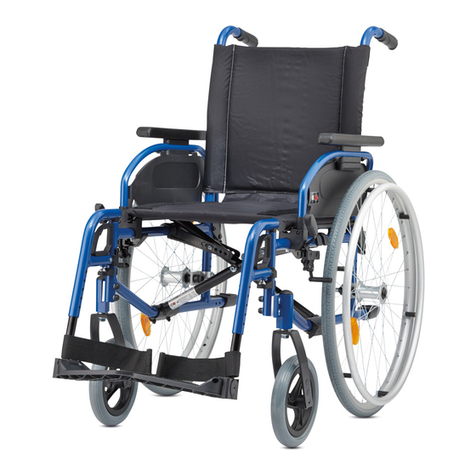
Bischoff & Bischoff
Bischoff & Bischoff Pyro Start Plus instruction manual
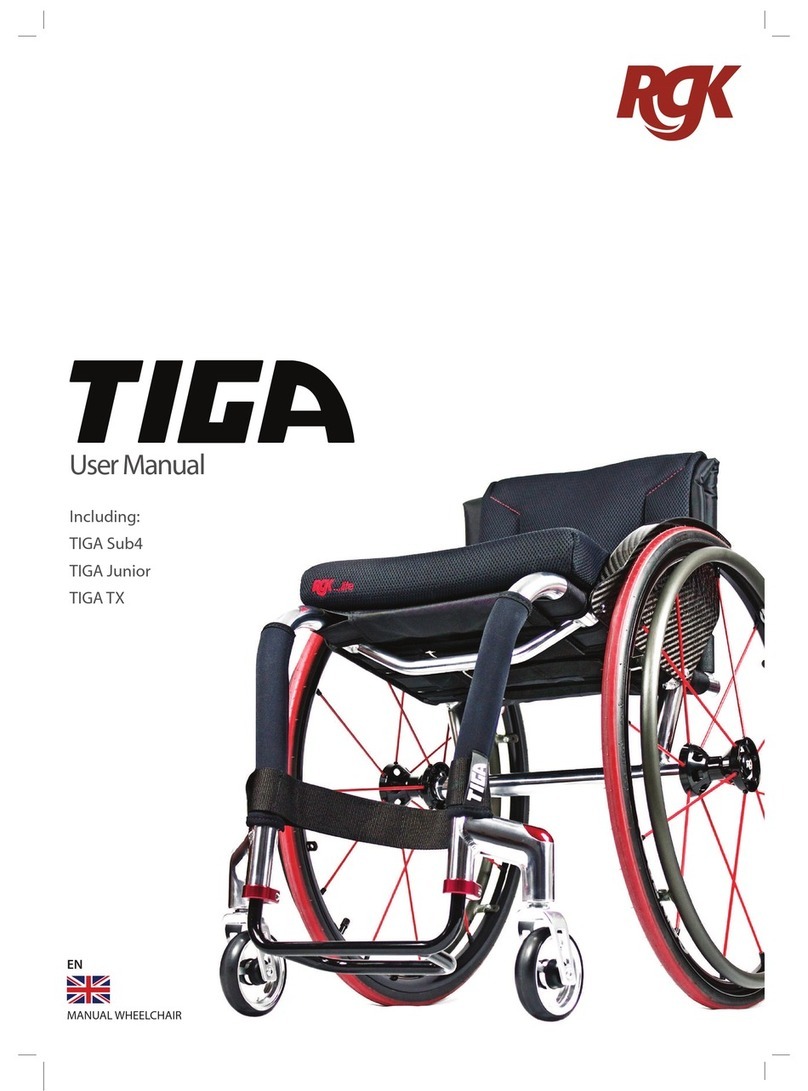
TIGA
TIGA Sub4 user manual

Airgo
Airgo 700-3 series owner's manual
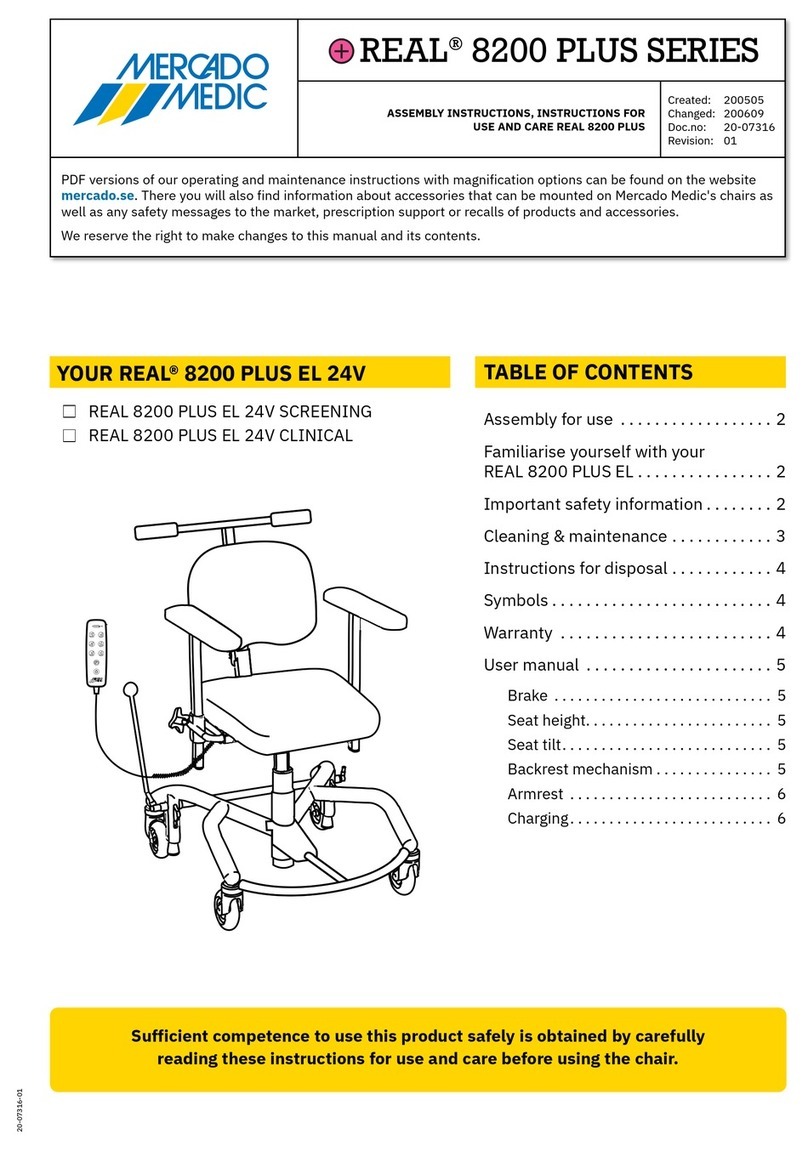
Mercado Medic
Mercado Medic REAL 8200 PLUS SERIES ASSEMBLY INSTRUCTIONS, INSTRUCTIONS FOR USE AND CARE

Vermeiren
Vermeiren Trigo S-line user manual
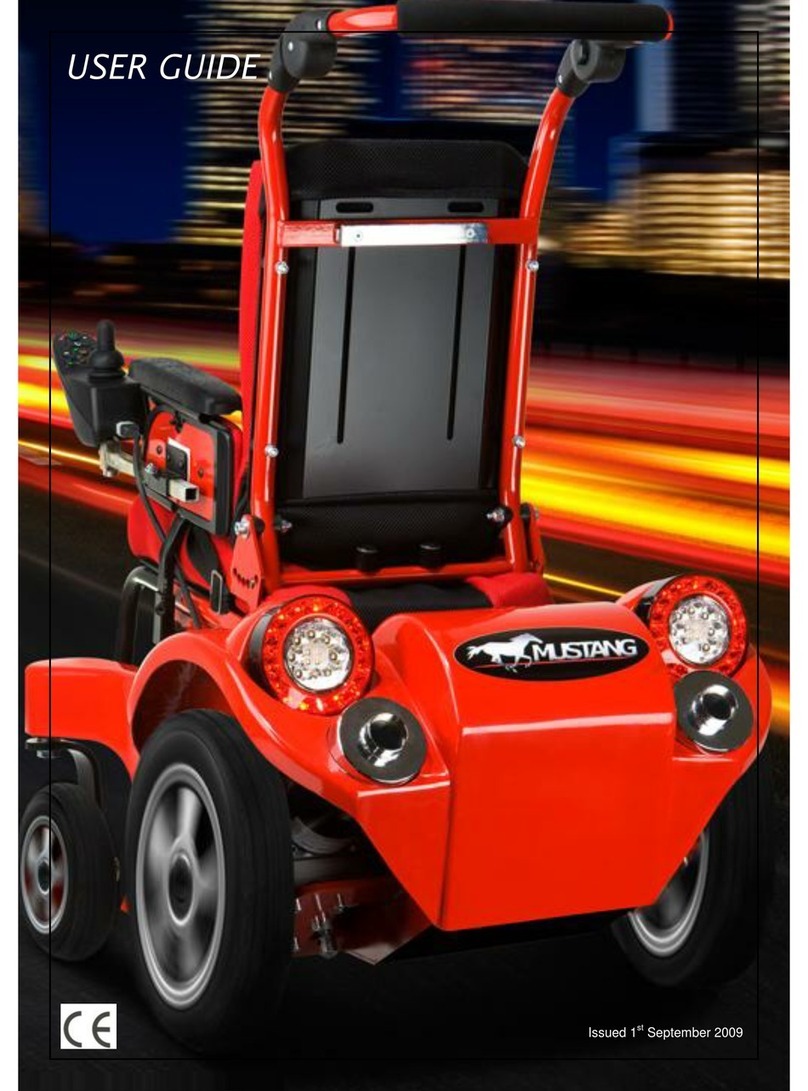
Activate
Activate MUSTANG user guide




